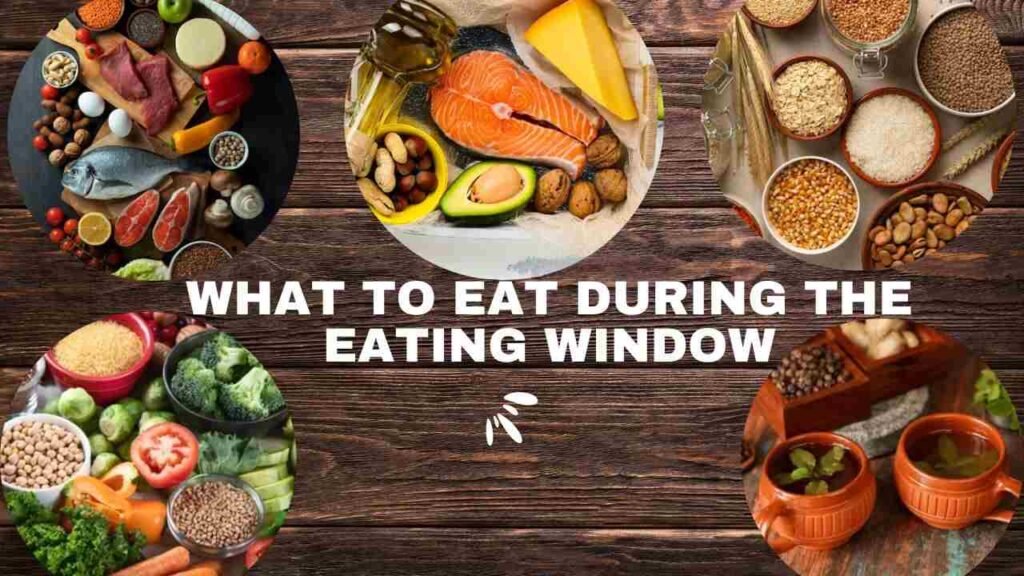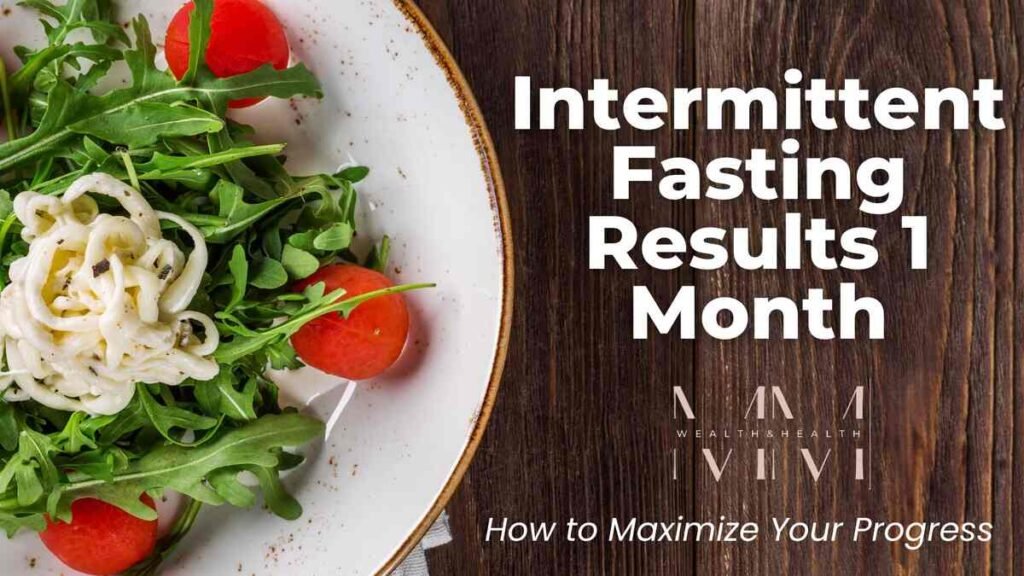Introduction
If you’ve just started or are considering an intermittent fasting plan and are wondering, “What will my intermittent fasting results 1 month look like?“. With the surge of interest in time-restricted eating, more people are ditching traditional diets for smarter, sustainable eating patterns that actually work.

It sounds simple, just change when you eat. But stick with it for a month, and you might just feel like a new person. More energy, less stress around food, and real changes you can see and feel.
If you’re curious about intermittent fasting results in 1 month, this detailed guide will walk you through the physical, mental, and metabolic changes you may experience. We’ll also explore scientific studies, best practices, and common challenges, so you can maximize your best results.
What Is Intermittent Fasting (IF)?
Intermittent fasting isn’t just another diet, it’s a lifestyle shift. And the beauty lies in its simplicity: instead of obsessing over what you eat, you focus on when you eat.

This approach is based on a flexible eating pattern that alternates between periods of eating and hours of fasting. During those fasting hours, your body gets the chance to reset, and that’s where the magic happens.
Let’s break down the most popular fasting styles so you can find what fits you best:
16:8 Method – A Gentle Start
You fast for 16 hours and eat during an 8-hour window. Most people skip breakfast, eat their first meal around noon, and finish eating by 8 pm.
Why it works: After around 12 hours of fasting, your body begins using stored fat for energy instead of glucose. This shift is called the metabolic switch, and its key to fat loss and improved energy. Best suited for: beginners, busy individuals, and anyone looking for a simple, sustainable starting point.
18:6 Method – A Bit More Structured
You fast for 18 hours and eat within a 6-hour window. Typically, the first meal is around 1–2 pm and the last one by 7–8 pm.
Why it works: You spend more time in the fasting state, allowing your body to burn more stored fat.
Best suited for: those who want enhanced fat-burning benefits and better metabolic flexibility.
Alternate-Day Fasting – Powerful Results on a Flexible Routine
This method alternates between eating normally one day and either fasting completely or consuming a very low-calorie intake (about 500–600 calories) the next.
Why it works: It gives your body extended recovery time from digestion and helps lower insulin levels more effectively. Research suggests that Alternate-day fasting may lead to significant weight loss and improved metabolic health.
Best suited for: individuals seeking faster results and who can manage more structured fasting intervals.
5:2 Fasting – Simple, Flexible, and Practical
Eat normally for 5 days, and on 2 non-consecutive days, reduce your intake to about 500–600 calories.
Why it works: Your body benefits from fasting without daily effort, and it allows you to maintain your usual routines on most days.
Best suited for: people wanting long-term results with less daily planning or restriction.
To learn more about intermittent fasting, visit our blog: Intermittent Fasting — The Best Guide to a Healthier Life.
What Happens During the Fast?
During your hours of fasting, your body starts to use up its glycogen stores and then shifts to burning stored fat for energy. This transition, called the metabolic switch, is one of the key mechanisms behind intermittent fasting’s success.

The switch also leads to better insulin sensitivity, reduced blood sugar, and lower insulin levels, supporting healthier weight management and reducing the risk of chronic diseases.
The best part is you don’t have to meticulously count calories or follow rigid meal plans. You just need to stay consistent with your eating schedule, choose nutrient-dense foods during your periods of eating, and allow your body the space to recover and thrive.
Intermittent Fasting Results 1 Month – The Real Changes
1. Significant Weight Loss and Fat Loss
Most people see noticeable fat burning and weight loss results within the first month.
- A systematic review found that IF leads to significant weight loss, with an average weight loss of 3-8% of body weight over several weeks.
- Another study showed significant reductions in waist circumference, indicating visceral fat loss.
- Unlike traditional diets, IF helps preserve muscle mass while burning stored fat.
🔹 Key Takeaway: Expect 3-10 lbs of weight loss in the first month, depending on your starting weight, calorie intake, and physical activity level.
Average weight loss: According to a systematic review, IF leads to significant reductions in body weight (4–10 pounds) in just 4 weeks, especially when paired with fewer calories and improved food choices.
In short, you may notice:
- Slimmer waist circumference
- Decreased body weight
- Lower caloric intake
- Increased metabolic flexibility
2. Improved Insulin Sensitivity & Blood Sugar Control
Intermittent Fasting can lower blood glucose and improve insulin resistance, reducing the risk of diabetes mellitus.
- A study in Cell Metabolism found that time-restricted feeding improved insulin levels and reduced blood sugar spikes.
- Another study noted beneficial effects on metabolic syndrome, including better cholesterol levels and blood pressure.
🔹 Key Takeaway: IF helps regulate blood sugar, making it an effective way to combat insulin resistance.
A study from Harvard Health shows that intermittent fasting may enhance insulin sensitivity and decrease blood sugar swings.
3. More Energy and Mental Clarity
Forget afternoon crashes. With an optimized fasting window, many report elevated energy levels, sharper focus, and fewer mood swings. This may be due to the body operating on ketones (fats) instead of glucose. Many IF practitioners report higher energy levels and enhanced cognitive function.
- Fasting triggers ketosis, where the body burns fat stores for fuel, leading to steady energy.
- Some studies suggest IF reduces oxidative stress, improving brain health.
🔹 Key Takeaway: Say goodbye to afternoon crashes, many people feel more focused and alert after adapting to IF.
4. Improved Body Composition
Even if the scale doesn’t move dramatically, your body composition often improves. Less fat, more muscle mass, especially when paired with strength training. You could feel a significant change with healthy weight loss in a great way.
- Intermittent fasting helps your body burn stored fat while holding on to muscle mass.
- Pairing fasting with strength training can lead to a more toned and lean look.
- As you lose fat and build muscle, your waist gets smaller, and your clothes fit better, even if your weight stays the same.
- This is what people mean when they say their body “recomposes.” Less fat, more definition.
- It’s not about losing “weight” fast. It’s about losing the right kind of weight, fat, not muscle.
🔹Key takeaway: You may not see dramatic weight loss right away, but your mirror will show you the real results.

5. Reduced Inflammation and Oxidative Stress
Animal studies and human trials both suggest that intermittent fasting reduces oxidative stress, lowers plasma concentrations of inflammatory biomarkers, and may support recovery and longevity. There are also chances of reducing the risk of heart disease.
- Research shows that IF improves cholesterol levels and blood pressure.
- A study in Nutrition Research found that IF reduces oxidative stress, a key factor in chronic diseases.
🔹 Key Takeaway: IF isn’t just about weight loss; it supports long-term overall health.
📖 Read: Effects of Intermittent Fasting on Inflammatory Biomarkers
Intermittent Fasting Period and Potential Benefits
| Fasting Method | Fasting Period | Eating Window | Potential Benefits |
|---|---|---|---|
| 12:12 (Beginner Level) | 12 hours of fasting | 12 hours of eating | Easy to start with, helps balance blood sugar, and improves discipline |
| 16:8 (Popular Method) | 16 hours of fasting | 8-hour window | Boosts fat burning, improves insulin sensitivity, and reduces calorie intake |
| 18:6 | 18 hours of fasting | 6 hours eating | Stronger fat loss results, deeper metabolic switch, reduced insulin resistance |
| 24-Hour Fast | 24 hours of fasting | No regular meal window | Triggers autophagy, reduces inflammation, and may lower cholesterol levels |
| Alternate-Day Fasting | ~36 hours (every other day) | Regular meals on eating days | Promotes metabolic flexibility, reduces calorie intake, and improves heart health |
What Should You Eat During the Eating Window?
Just because it’s your eating window doesn’t mean it’s time to load up on junk food. One of the biggest mistakes people make with intermittent fasting is thinking they can eat anything they want during the hours they’re allowed to eat. But here’s the truth: what you eat during those periods of eating matters just as much as when you eat.
To get the health benefits of intermittent fasting, like better blood sugar control, more energy, and fat loss, you need to nourish your body with the right foods. That means focusing on nutrient-dense foods that support your metabolism, fuel your day, and keep you feeling satisfied.
Here’s what your plate should look like:
1. Lean Proteins
Think grilled chicken, turkey, eggs, tofu, or fish. These support muscle recovery, help maintain muscle mass, and keep you full for longer, especially important if you’re trying to avoid weight gain and support a healthy calorie intake.
2. Healthy Fats
Add a few slices of avocado to your salad or drizzle olive oil over roasted veggies. Nuts and seeds are great too. Healthy fats keep hormones balanced and help your body absorb vitamins better.

3. Whole Grains
Swap white rice and bread for whole grains like quinoa, brown rice, oats, or whole-wheat wraps. These are more filling, provide steady energy, and help reduce cravings during your fasting window.
4. Fiber-Rich Vegetables
Fill half your plate with veggies like spinach, kale, carrots, cauliflower, or broccoli. These fiber-rich vegetables are low in calories but packed with nutrients that help digestion and support long-term health.
5. Black Coffee or Herbal Tea
During or even outside your eating window, a cup of black coffee or herbal tea can give you a little energy boost and help control hunger. Both have almost no calories and can support your fast, just don’t add sugar or cream.
Remember, intermittent fasting works best when it’s paired with smart food choices. It’s not just about skipping meals, it’s about training your body to run on real, wholesome food intake.
“Intermittent fasting isn’t about eating less, it’s about eating smart, at the right time.”
What Happens Week by Week During Intermittent Fasting?
So, you’re a few days into intermittent fasting and wondering, “Is this even working?” The truth is, yes, but the changes happen gradually. Here’s what many people experience during the first month of IF, broken down into real-life weekly changes.
First Week – Welcome to the Adjustment Phase
You might notice hunger pangs kicking in right on schedule with your old habits. It’s your body’s way of saying, “Hey, where’s my snack?” Cravings for sugar or salty food are common, and you might feel a little off, light-headed, low on energy, or unusually tired.
The real challenge? Getting used to your new eating schedule. Your body is transitioning from grazing mode to a structured rhythm, and that takes effort. Some people even feel mild fatigue, especially during their fasting hours.
This is your body’s first taste of metabolic adaptation. You’re easing into it, so don’t rush. Be patient with your system.
Second Week – More Energy, Less Resistance
By now, your body is catching on. You might still feel hungry, but not as often or as intensely. More importantly, you may feel steadier. Your energy levels begin to improve. Some people feel lighter, mentally and physically.
With fewer random snack attacks, you have better control over your caloric intake. Your brain is adjusting, too; those once-frequent “I need a snack!” thoughts become less frequent.
Your fasting regimen starts to feel natural. The transition from fasting to eating becomes smoother, and you’re less likely to overeat during your eating window.
You’re not just fasting anymore. You’re finding your groove.
Third Week – Noticeable Fat Loss & Mood Boosts
This is often when people begin seeing outward results. While your body weight may not have dramatically changed, you start noticing a better fit in your clothes. Jeans that were snug a few weeks ago might feel looser now.
Internally, your body is thriving. You’re likely seeing fat loss rather than just water weight, and your overall mood improves, hello, positive changes in how you feel and function.

You may also notice improved sleep and reduced blood pressure. Your blood glucose levels begin to stabilize, making you feel less jittery or tired between meals.
This week is often a major motivator. You can see and feel the difference.
Fourth Week – Mental Clarity and Sustainable Habits
By week four, things begin to feel… easier. You’re not just following an eating plan; you’ve created a sustainable eating pattern. Your relationship with food has started to shift.
You might feel sharper and more focused throughout the day. That sluggish afternoon crash? Largely gone. Many people report an increase in mental clarity and improved cognitive function by this point.
You’ll likely see a more measurable drop in body weight, and your clothes might fit even better. Your body’s rhythm between periods of eating and fasting becomes second nature. You’re no longer constantly thinking about food; you eat when it’s time and move on.
Mind and body both benefit here. It’s not a fad anymore, it’s a lifestyle in motion.
Real Results Take Time and vary
Every person’s fasting journey is unique. But if you stay consistent over these periods, the transformation is often deeper than the scale can show. From improved energy and mood to sustainable weight control and mental clarity, intermittent fasting results after 1 month can be a real game-changer.
Scientific Studies that Back It All
If you’ve been wondering whether intermittent fasting is worth trying, science has your back. Multiple trusted studies have shown how powerful this simple shift in eating habits can be.
For instance, a review from the National Library of Medicine found that intermittent fasting may help lower the risk of chronic diseases like diabetes mellitus, heart disease, obesity, and even certain types of cancer. That’s a pretty big deal for something that doesn’t require counting every single calorie.
Other studies published in the Journal of Translational Medicine explain that fasting can lead to beneficial effects on your metabolic health, meaning your body processes food and energy more efficiently. It’s also been shown to help improve cholesterol levels and blood pressure, which are two things most of us don’t pay attention to… until we have to.
A PubMed Meta Analysis also revealed some amazing results: people saw significant weight loss, reduced waist circumference, and better energy intake regulation, so your body gets smarter about when and how much energy it needs.
Common Challenges in the First Month
When you start intermittent never expect a rapid fat loss in the first few weeks. The first month can feel like a rollercoaster, and that’s completely normal. However, you should know the challenges and how to overcome them.
Biggest Challenges
Hunger pangs can hit hard in the early days, especially if you’re used to snacking around the clock. But don’t worry, your body will adjust.
Social life can take a hit, too. Friends might plan dinners or meet-ups that clash with your eating period, making it awkward to say no or explain why you’re skipping that 8 p.m. dessert.
And then there’s the dip in energy, yep, workouts can feel a little tougher at first while your body adapts to using stored energy instead of constant snacks.
How to Overcome Them
These early struggles don’t last forever. With a few smart tweaks, you can make your first month way more manageable and even enjoyable.
Start with shorter fasts like 12:12 or 14:10. No need to jump straight into 16-hour fasts. Easing in gently gives your body time to adapt without feeling drained.
Sip on black coffee or herbal tea during your fasting hours. They can help tame hunger and keep you feeling more alert. Just be sure there’s no sugar or milk; those can break your fast. You can find the best alternative.
Focus on real, nourishing foods during your eating window. Think lean proteins like chicken, eggs, or tofu, and pair them with fiber-rich whole grains. These foods keep you full for longer and support better energy levels throughout the day.
Stick to your fasting schedule, even if the next day feels tough. Building that routine is the real secret. Some days will be harder than others, but it’s the consistency that brings results.
“Discipline today brings better results tomorrow.”
1. How much weight can I lose in a month with intermittent fasting?
Most people lose 4–10 pounds in the first month, especially when combined with regular physical activity, a mindful starting weight, and controlled caloric intake. You’ll also notice better results like less bloating, stable energy, and clearer focus, even if the scale doesn’t budge dramatically.
2. Is it better than traditional diets?
Often, yes. Unlike continuous calorie restriction, fasting lets your body tap into fat stores and reset naturally. It feels more sustainable in the long term because it focuses on when you eat, not just what you eat.
3. Can I drink coffee while fasting?
Yes! Black coffee (no sugar or cream) is fasting-friendly. It helps curb hunger and boosts energy levels without breaking your fast.
4. What’s the best way to avoid breaking a fast?
Stick to nutrient-dense foods during your eating window, like lean proteins, healthy fats, and vegetables. Skip junk food and sweets to stay full and balanced longer.
5. Will it still work if I don’t exercise?
Yes! You’ll still see improvements in body composition and metabolic health. But pairing fasting with any movement, even walking, may lead to more significant weight loss.
Amazing Book to transform you!
If you’re ready to transform your health, energy, and confidence from the inside out, Intermittent Fasting for Women by Patricia Nestor is the book you’ve been waiting for. This isn’t just another guide, it’s a powerful blueprint designed specifically for women, with every chapter speaking directly to the hormonal and metabolic shifts that make our bodies unique.
Patricia Nestor doesn’t just tell you to fast, she shows you how to do it in a way that feels right, works with your lifestyle, and actually delivers results. Whether you’re looking to lose stubborn weight, feel more energized throughout your day, or finally get your hormones back in sync, her approach is clear, compassionate, and backed by real-life results.
This book is more than a plan—it’s a mindset shift. A lifestyle upgrade. And most importantly, it’s a reminder that you are in control of your health. Patricia gives you the tools. You’ll do the rest—and you’ll never look back.
Is 1 Month of Intermittent Fasting Worth It?
Absolutely. In just 30 days, you can experience real, measurable shifts, not just on the scale, but in how you feel, think, and function. From weight loss results to better insulin sensitivity, mental clarity, and metabolic flexibility, intermittent fasting can transform your health without the stress of counting every calorie.
Stick with it. Adjust your fasting method and eating window to what works for you.
“You don’t have to get it all right on day one. Just begin, and let each day move you closer to the results you deserve.”
Start small. Stay consistent. And watch your body, thank you.
Got questions or need help building your fasting routine? Drop them in the comments, let’s figure it out together!



